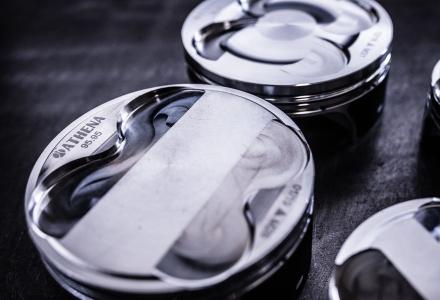White Smoke from Exhaust: What Does It Mean?
White smoke from exhaust when starting your motorcycle is a relatively common event, especially in winter. It is not always a sign of trouble, but it should not be underestimated. If the white smoke from the exhaust is significant, persistent, or accompanied by a loss of engine power and decreased motorcycle performance, it might indicate a more serious issue.
In this article, we will review why white smoke comes out of a motorcycle's exhaust, learn to recognize situations of concern, and understand what to do to fix the issue.
Why White Smoke Comes Out of a Motorcycle's Exhaust
White smoke from exhaust is essentially an indicator of water in the exhaust system or coolant in the engine's combustion chamber. In most cases, this can be attributed to condensate forming inside the exhaust, but it could also indicate a more serious issue with the cooling system.

White Smoke from the Exhaust at Startup then Disappears
The emission of white smoke from exhaust on startup when starting a cold engine is quite common in winter, especially for motorcycles parked outdoors, as ambient humidity can freely penetrate and accumulate in the exhaust system. This leads to condensation inside the exhaust, which quickly evaporates with the heat generated by the running engine, causing white smoke that disappears after a few minutes.
Another situation that can lead to white smoke from exhaust formation is water in the exhaust tip following a vehicle wash. Starting the engine under these conditions can cause temporary white smoke from the exhaust due to the evaporation of water accumulated in the exhaust.
White Smoke and Water coming out of the Exhaust Pipe
In the cases just described – after outdoor parking at night or washing the motorcycle – it is not unusual to notice, in addition to white smoke, water coming out of the exhaust pipe when starting the vehicle. If the amount of water droplets is relatively small and the smoke disappears after a couple of minutes, there is no need to worry: the temporary presence of white smoke and water is a consequence of environmental conditions or motorcycle washing and does not compromise the motorcycle's performance or road safety.
If you still want to avoid this issue, we recommend isolating the exhaust pipe during overnight parking or washing operations: for this purpose, you can use Athena plugs to cap the exhaust tip.

White Smoke from Exhaust and Loss of Engine Power
When white smoke from the exhaust is continuous and persistent, even after the engine is running, this is something that should not be underestimated, as it may indicate a more serious issue.
In this case, continued use of the vehicle may lead to a noticeable loss of motorcycle power, with a marked decrease in maximum speed and acceleration. The performance drop usually does not happen suddenly but appears gradually with continuous use of the vehicle after the onset of the white smoke from the exhaust.
The reduction in performance is a direct result of one or more engine cylinders malfunctioning. This leads to inefficient combustion, resulting in a loss of engine power.
For example, this can occur with a burnt head gasket that loses its sealing function and no longer prevents the coolant from entering the combustion chamber. Inside, the coolant comes into contact with the heat generated during combustion. This heat exchange leads to the rapid evaporation of the liquid, generating the white smoke that then comes out of the exhaust pipe.
White Smoke from the Exhaust and Burnt Smell
Alongside white smoke coming from the exhaust and reduced motorcycle performance, you may also smell a pungent odor coming from the motorcycle's exhaust, resulting from the burning coolant.
This unusual smell is distinct from the typical burning odor. The latter occurs in cases of combustion problems and “rich” carburation, with an excessive presence of gasoline in the cylinders, and is usually associated with black smoke from the motorcycle's exhaust pipe.
What to Do if Thick White Smoke Is Coming from the Exhaust of My Motorcycle?
As already mentioned, white smoke is not always a sign of a costly and worrying issue. Check if the white smoke is only temporary, especially in winter, when you start the motorcycle in the morning.
If the smoke dissipates almost immediately, emits no odor, and does not persist while driving, then there is no need to worry. However, if you notice a significant amount of thick white smoke while driving, it is advisable to reduce speed and proceed with caution.
If you see thick white smoke coming from the motorcycle's exhaust, it is time to make sure that the head gasket seal is not compromised. You can get an indication of a possible malfunction of the engine's head gasket by checking the condition of the coolant: this is a simple check that can be done independently, as described below.
- With the engine cold, open the coolant expansion tank and start the engine.
- If you notice bubbles in the coolant, this indicates that it has come into contact with the exhaust gases and that the head gasket is damaged, losing its seal capacity.
In any case, if the white smoke from the exhaust is persistent or even associated with a pungent odor and a loss of power, it is advisable to take the motorcycle to a workshop for an expert and professional inspection: this will avoid potential engine damage that can progressively worsen and, above all, jeopardize driving safety.
How to Fix White Smoke from Exhaust
To eliminate white smoke from exhaust and any water leakage when starting the motorcycle, it is sufficient to avoid leaving the motorcycle outdoors overnight – especially in winter – and to use an exhaust tip plug when washing the motorcycle.
However, if persistent white smoke is indicative of a problem with the head gasket, replacing this component is essential to restore proper seal and prevent further engine damage.
On the Athena website, you can find the Top end gasket kits, which ensure maximum seal and mechanical resistance, as well as resistance to oils and gasoline, high temperatures, and pressures, in addition to individual head gaskets.
Generally, keep in mind that replacing the head gasket is a fairly complex task. So, we recommend turning to a professional unless you are extremely familiar with the assembly and disassembly of engine parts.
The cost starts at about 300 dollars, but it varies depending on the motorcycle model and the components involved. Replacing the head gasket on an Enduro motorcycle with a single-cylinder engine is a simpler operation than that on a street motorcycle with a 4-cylinder engine, which will cost more.
Replacing the head gasket will restore the airtight seal of the combustion chamber and prevent contamination between the coolant, combustion gases, and oil. In addition to eliminating white smoke from exhaust, the procedure is also crucial to avoid engine overheating and restore proper lubrication, thereby averting potentially more serious and expensive damage to the inner engine parts.




